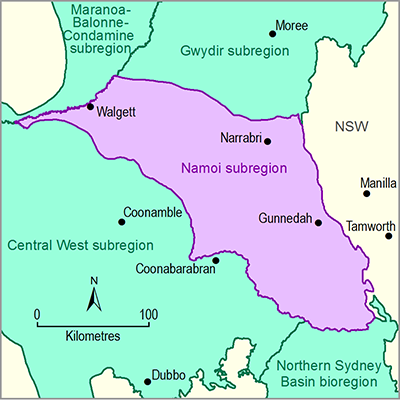- Home
- Assessments
- Bioregional Assessment Program
- Namoi subregion
- 3-4 Impact and risk analysis for the Namoi subregion
- 3.7 Conclusion
- 3.7.3 Using this impact and risk analysis
Findings from BAs can help governments, industry and the community provide better-informed regulatory water management and planning decisions.
Assessment results flag where future efforts of regulators and proponents can be directed. This is emphasised through the rule-out process, which focuses attention on areas where hydrological changes are predicted. In doing so, it has identified areas, and consequently water resources and water-dependent assets, that are very unlikely (less than 5% chance) to experience hydrological change or impact due to additional coal resource development.
This Assessment predicts the likelihood of exceeding levels of potential hydrological change at a regional level. It also provides important context to identify potential issues that may need to be addressed in local-scale environmental impact assessments of new coal resource developments. It should help project proponents to meet legislative requirements to describe the effects of underground water use on environmental values and to adopt strategies to avoid, mitigate or manage the predicted impacts. This Assessment does not investigate the broader social, economic or human health impacts of coal resource development, nor does it consider risks of fugitive gases, non-water-related impacts and the broader water quality implications.
BAs are not a substitute for careful assessment of proposed coal mine or coal seam gas (CSG) extraction projects under Australian or state environmental law. Such assessments may use finer-scale groundwater and surface water models and consider impacts on matters other than water resources. However, the Independent Expert Scientific Committee on Coal Seam Gas and Large Coal Mining Development (a federal government statutory authority established in 2012 under the Commonwealth’s Environment Protection and Biodiversity Conservation Act 1999) and relevant state regulators may use results from this Assessment in formulating their advice.
BAs have been developed with the ability to be updated, for example, to incorporate new coal resource developments in the groundwater model. Existing datasets, such as the water-dependent asset register, remain relevant for future assessments. If new coal resource developments emerge in the future, the data, information, analytical results and models from this Assessment would provide a comprehensive basis for a subregion-scale re‑assessment of potential impacts under an updated coal resource development pathway (CRDP). It may also be applicable for other types of resource development.
The full suite of information, including information for individual assets, is provided at www.bioregionalassessments.gov.au with more detailed results available for:
- potential hydrological changes at www.bioregionalassessments.gov.au/explorer/NAM/hydrologicalchanges
- potential impacts on landscapes at www.bioregionalassessments.gov.au/explorer/NAM/landscapes
- potential impacts on water-dependent assets at www.bioregionalassessments.gov.au/explorer/NAM/assets.
Access to underpinning datasets, including spatially explicit geographic data and modelling results, can assist decision makers at all levels to review the work undertaken to date; to explore the results using different thresholds; and to extend or update the assessment if new models or data become available. Additional guidance about how to apply the Bioregional Assessment Programme’s (the Programme) methodology is also documented in detailed scientific submethodologies (Table 1).
The Programme’s rigorous commitment to data access is consistent with the Australian Government's principles of providing publicly accessible, transparent and responsibly managed public-sector information.

Product Finalisation date
- 3.1 Overview
- 3.2 Methods
- 3.3 Potential hydrological changes
- 3.4 Impacts on and risks to landscape classes
- 3.4.1 Overview
- 3.4.2 Landscape classes that are unlikely to be impacted
- 3.4.3 'Floodplain or lowland riverine' (non-Pilliga) landscape group
- 3.4.4 'Non-floodplain or upland riverine' (non-Pilliga) landscape group
- 3.4.5 Pilliga riverine (upland and lowland)
- 3.4.6 Potentially impacted landscape classes lacking quantitative ecological modelling
- References
- Datasets
- 3.5 Impacts on and risks to water-dependent assets
- 3.6 Commentary for coal resource developments that are not modelled
- 3.7 Conclusion
- Citation
- Acknowledgements
- Contributors to the Technical Programme
- About this technical product
